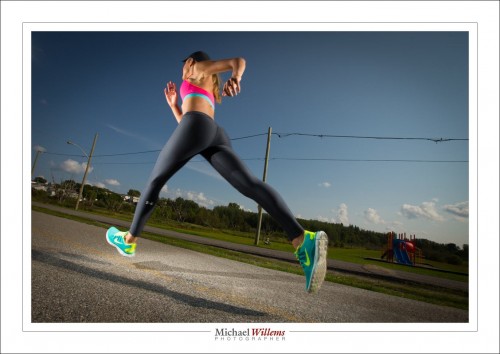So the day yesterday in Timmins I had the following shot firmly in mind:
But that was mind only. I needed a setting – friends and students Aurele and Lisa came up with the perfect location for what I had in mind, and Savannah, the model, had a jogging outfit, and is a runner. Serendipity!
So now the shot. If I were to get low to the ground, use my widest lens, and use available light, I would get this (this was my composition test shot):
So then I go to work.
To get the saturated look I like, I want to darken the background, ambient, light by two stops. I start at the usual sunny day settings of 1/250th sec at 100 ISO. That gives me f/11. So that makes me use two speedlights direct on front of the model and one behind; all set to half power. One light gives me f/8, so two lights around f/11. See the two flashes on the left:
One on a light stand, one attached lower to the same light stand with a clamp. Used at half power, while I perhaps would have preferred quarter power (they are Nikon flashes, so will overheat) – but half power is better than full power.
Now, walking like an Egyptian, I explain the idea to my students:
And there we have it – now all I needed to do is agree on the spot; prefocus (so there’s no delays); and shoot. That took a few attempts, but not many: out of seven tries, two were perfect. Here’s the second of those:
Post work consisted merely of removing a few unwanted shadows and background objects, and I had the exact shot I had in mind. And my students did too, and they learned the process, and they fully got it. It’s nice when it all comes together.






Hey Mike,
Why do you not use ETTL in this setting?
Because with all the pre-flashes, it takes longer, mainly. Also, the runner’s clothes would then make a difference and I might have to compensate. Finally, I would have to have a light path to all flashes. One is behind her.
Meek sense?